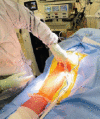Proximal Hamstring Repair - Surgical Pearls for the Novice
- PMID: 35415144
- PMCID: PMC8930380
- DOI: 10.13107/jocr.2021.v11.i12.2588
Proximal Hamstring Repair - Surgical Pearls for the Novice
Abstract
Introduction: Proximal hamstring injuries are rarely encountered sport injuries which cause great functional impairment in the activities of performance. Since these injuries are rarely encountered in orthopedic training, many young surgeons find it challenging to explore and successfully perform the required repairs. The technical demands of tendon retraction, scar tissue formation along with a great possibility of nerve injury during surgical dissection make these procedures a nightmare for young surgeons.
Results: Between January 2020 and December 2021, 11 patients underwent a proximal hamstring repair at our practice. All cases were of acute hamstring tears and diagnosed on magnetic resonance imaging (MRI) evaluation post-injury. No repeat MRI was performed but the patients outcomes were judged based on clinical outcomes such as return to sport or the presence of residual pain. All patients reached their pre-injury level of activity within 6 months of surgical repair.
Conclusion: This technical note describes pearls of surgical repair of these injuries that help in better execution of such injuries with minimal soft tissue damage and complications.
Keywords: Proximal Hamstring tear; hamstring avulsion; hamstring repair.
Copyright: © Indian Orthopaedic Research Group.
Conflict of interest statement
Conflict of Interest: Nil
Figures







References
-
- Cvetanovich GL, Saltzman BM, Ukwuani G, Frank RM, Verma NN, Bush-Joseph CA, et al. Anatomy of the pudendal nerve and other neural structures around the proximal hamstring origin in males. Arthroscopy. 2018;34:2105–10. - PubMed
-
- Blakeney WG, Zilko SR, Edmonston SJ, Schupp NE, Annear PT. A prospective evaluation of proximal hamstring tendon avulsions:Improved functional outcomes following surgical repair. Knee Surg Sports Traumatol Arthrosc. 2017;25:1943–50. - PubMed
Publication types
LinkOut - more resources
Full Text Sources
